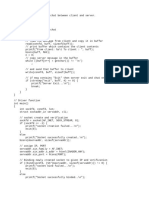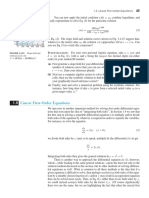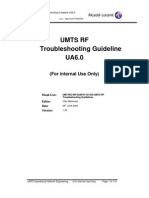National Institute of Technology, Rourkela
DCCN Lab (CS3072)
6th Semester – 2025 Spring Sem
Client-Server message sending
TCP Server in C
#include <stdio.h>
#include <stdlib.h>
#include <string.h>
#include <unistd.h>
#include <arpa/inet.h>
#define PORT 8080
#define BUF_SIZE 1024
int main() {
int server_fd, client_fd;
struct sockaddr_in server_addr, client_addr;
socklen_t addr_len = sizeof(client_addr);
char buffer[BUF_SIZE];
// Create socket
if ((server_fd = socket(AF_INET, SOCK_STREAM, 0)) == -1) {
perror("Socket creation failed");
exit(EXIT_FAILURE);
� }
server_addr.sin_family = AF_INET;
server_addr.sin_addr.s_addr = INADDR_ANY;
server_addr.sin_port = htons(PORT);
// Bind the socket to the IP address and port
if (bind(server_fd, (struct sockaddr*)&server_addr,
sizeof(server_addr)) == -1) {
perror("Bind failed");
close(server_fd);
exit(EXIT_FAILURE);
// Listen for incoming connections
if (listen(server_fd, 5) == -1) {
perror("Listen failed");
close(server_fd);
exit(EXIT_FAILURE);
printf("Server is listening on port %d...\n", PORT);
// Accept incoming connections
if ((client_fd = accept(server_fd, (struct sockaddr*)&client_addr,
&addr_len)) == -1) {
perror("Accept failed");
� close(server_fd);
exit(EXIT_FAILURE);
printf("Connection established with client\n");
// Receive message from client
int bytes_received = recv(client_fd, buffer, BUF_SIZE, 0);
if (bytes_received == -1) {
perror("Receive failed");
close(client_fd);
close(server_fd);
exit(EXIT_FAILURE);
buffer[bytes_received] = '\0'; // Null-terminate the string
printf("Received from client: %s\n", buffer);
// Send a response to the client
const char* response = "Message received";
send(client_fd, response, strlen(response), 0);
// Close the connection
close(client_fd);
close(server_fd);
return 0;
�}
TCP Client in C
#include <stdio.h>
#include <stdlib.h>
#include <string.h>
#include <unistd.h>
#include <arpa/inet.h>
#define PORT 8080
#define BUF_SIZE 1024
int main() {
int sock;
struct sockaddr_in server_addr;
char buffer[BUF_SIZE];
// Create socket
if ((sock = socket(AF_INET, SOCK_STREAM, 0)) == -1) {
perror("Socket creation failed");
exit(EXIT_FAILURE);
server_addr.sin_family = AF_INET;
server_addr.sin_port = htons(PORT);
� // Convert IP address to binary format
if (inet_pton(AF_INET, "127.0.0.1", &server_addr.sin_addr) <= 0) {
perror("Invalid address");
close(sock);
exit(EXIT_FAILURE);
// Connect to the server
if (connect(sock, (struct sockaddr*)&server_addr, sizeof(server_addr))
== -1) {
perror("Connection failed");
close(sock);
exit(EXIT_FAILURE);
printf("Connected to the server\n");
// Send message to the server
const char* message = "Hello from client!";
send(sock, message, strlen(message), 0);
// Receive server response
int bytes_received = recv(sock, buffer, BUF_SIZE, 0);
if (bytes_received == -1) {
perror("Receive failed");
close(sock);
exit(EXIT_FAILURE);
� }
buffer[bytes_received] = '\0'; // Null-terminate the string
printf("Received from server: %s\n", buffer);
// Close the socket
close(sock);
return 0;
How to execute
1. Open two terminals (one for server and the other for the client).
T1: gcc server.c -o server
./server
T2: gcc client.c -o client
./server
Assignment
1. Implement a client-server program where the client requests the addition of two
integers, the server performs the calculation, and the result is sent back to the client.
Use command-line arguments for input, including the server's IP address during
execution.
2. Implement a TCP client-server program where the client sends a string to the server,
and the server checks whether the string is a palindrome. The server should return the
result to the client.















































































